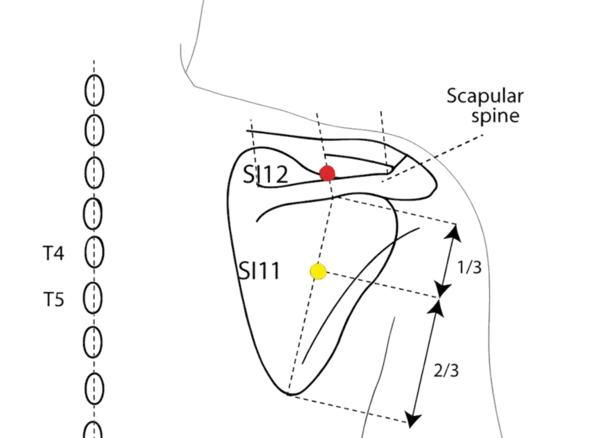SI-12 - Grasping the Wind
秉风 - Bǐng fēng
Point Region: Upper back
SI-12 Bingfeng, meaning 'Grasping the Wind,' is a meeting point of the SI, LI, TE, and GB channels. Located on the back, it is a key point for addressing a wide range of issues that are caused by 'wind' or stagnation in the upper back. Its name, 'Grasping the Wind,' alludes to its ability to bring a sense of order and harmony to the body's entire system.
Think of Bingfeng as a point that helps to 'grasp the wind' of your body. It's invaluable for addressing issues like a restless spirit, a feeling of 'heat' in the body, and a lack of vitality. By regulating the body's internal energy, it helps to restore a sense of ease and freedom.
By regulating the body's internal energy, SI-12 helps to restore a sense of balance and inner peace. It's a point that reminds us that our true power comes from a calm and unburdened body.
Location & How to Find
Anatomical Location: Located in the depression superior to the scapular spine.
How to Locate:
- Find the spine of your shoulder blade (horizontal ridge)
- Feel for the depression just above this ridge
- This is toward the upper part of your shoulder blade
- The point is in this hollow above the shoulder blade spine

Primary Functions
Musculoskeletal System
- Relieves shoulder and upper back pain
- Treats shoulder blade stiffness
- Reduces neck and shoulder tension
- Improves shoulder mobility
- Strengthens shoulder and back muscles
- Treats cervical spondylosis
Respiratory System
- Relieves chest congestion
- Improves breathing capacity
- Treats chronic cough
- Reduces shortness of breath
- Promotes lung function
Nervous System
- Alleviates nerve pain in shoulder
- Reduces headaches from neck tension
- Calms the nervous system
- Treats cervical radiculopathy
Circulatory System
- Improves circulation in upper body
- Reduces shoulder inflammation
- Promotes tissue healing
Clinical Applications
Primary Indications
- Shoulder pain
- Arm numbness
- Scapular tension
- Shoulder stiffness
- Upper back pain
- Arm weakness
Related Health Concerns
Common Conditions:
Related Acupoints
Select a point to learn about its location, primary functions, clinical applications, and protocols.
SI-12 Protocols
N/A
Important Precautions
- Recent shoulder surgery
- Severe shoulder blade fracture
- Acute upper back injury